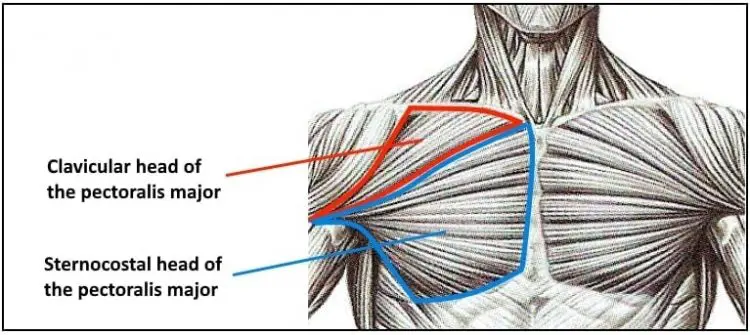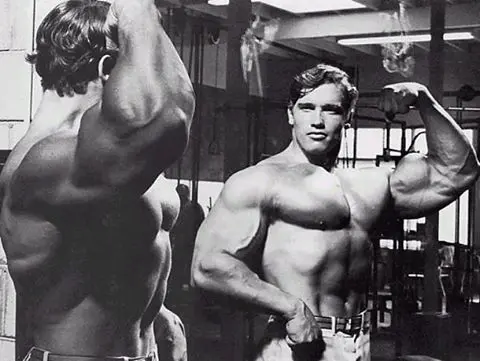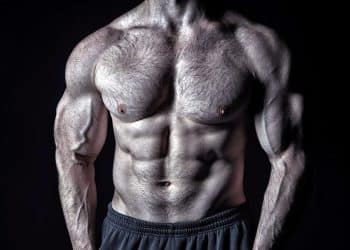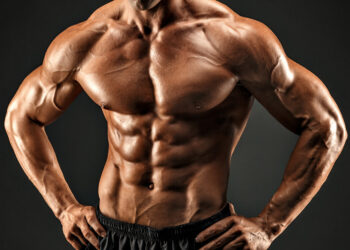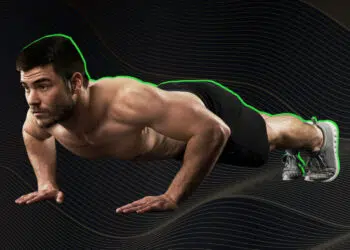As a veteran personal trainer with over 30 years of professional experience, I’ve helped numerous clients sculpt their best-ever physiques. This invariably involves assessing and fixing muscle weaknesses, such as narrow shoulders, a flat butt, or a less-than-perfectly developed chest.
Unfortunately, muscle shape is primarily dictated by genetics. Things like tendon and muscle belly length and attachment sites are unmodifiable.
That said, you can use special exercises and training methods to emphasize individual muscles and regions to create a more pleasing body shape.
With that in mind, in this article, I reveal the best inner chest exercises and workouts for a deeper, better-separated chest.
Recent Updates: On June 22, 2024, Fitness Volt’s Senior Editor Vidur Saini (American Council on Exercise-CPT) updated the article and added actionable expert tips throughout the piece to improve the reader experience. Level Up Your Fitness: Join our 💪 strong community in Fitness Volt Newsletter. Get daily inspiration, expert-backed workouts, nutrition tips, the latest in strength sports, and the support you need to reach your goals. Subscribe for free!
11 Best Inner Chest Exercises
We have shortlisted the best exercises to help improve your inner chest definition.
By doing each exercise with the correct technique, you can get the most from them while keeping your risk of injury low. If any of these exercises are new to you, use light weights until you have drilled the movement mechanics.
- Dumbbell Squeeze Press
- Machine Fly
- Dumbbell Fly/Narrow-Grip Bench Press Combo
- Standing Cable Hex Press
- Cable Crossover
- Narrow-Grip Smith Machine Bench Press
- Incline Dumbbell Fly
- Low Cable Chest Fly
- Svend Press
- Single-Arm Cross-Body Fly
- Single-Hand Banded Crossover
1. Dumbbell Squeeze Press
| Sets & Reps | Hypertrophy: 10-12 reps
Strength: 3-5 reps |
| Equipment Needed | Dumbbells |
| Target Muscles | Pectoralis major (chest), triceps brachii (arms), anterior deltoids (shoulders) |
The dumbbell squeeze press would be a good option if you only do one exercise for your inner chest. All you need is a pair of dumbbells and a bench, and you’re good to go. Really drive the dumbbells together to maximize inner pec recruitment.
“The isometric contraction at the top of the movement, where you squeeze the dumbbells together, activates additional inner chest muscle fibers for enhanced chest development,” says Saini.
How to do it:
- Lie on your back with a dumbbell in each hand. Pull your shoulders down and back, brace your core, and plant your feet firmly on the floor.
- Using a neutral grip, press the dumbbells together in front of your chest.
- Maintaining this inward tension, push the weights up to arm’s length.
- Lower the dumbbells back down to your chest and repeat.
Benefits:
- This is a compound movement that works your chest, shoulders, and triceps.
- Very little stress on your shoulder joints.
- A great exercise for home workouts when you don’t have much equipment available.
Pro Tip: Use hex dumbbells to prevent the weights from slipping. This makes it easier to press them together for an even better inner chest workout.
| Difficulty | Progression | Regression |
| Beginner | Incline dumbbell squeeze press | Conventional dumbbell press |
2. Machine Fly
| Sets & Reps | Hypertrophy: 10-15 reps
Strength: 3-5 reps |
| Equipment Needed | Pec deck machine |
| Target Muscles | Pectoralis major (chest) |
Pec deck flyes have helped many beginners gain basic adduction strength. Machine flyes enhance chest strength and help improve overall definition. They also go great with drop sets and supersets.
Saini suggests not overemphasizing the top contraction and focusing on controlled eccentrics (lowering phase) for peak chest engagement.
How to do it:
- After you choose your weight, set the seat height so that your arms are parallel to the floor when fully extended.
- Maintain a slight bend in your elbows throughout the movement.
- Grab handles at chest height while keeping your shoulders down and scapula retracted.
- Keep your back straight and chest out. Brace your core and plant your feet firmly on the floor.
- Exhale as you bring the handles together in a sweeping motion.
- Squeeze the contraction for a second before returning to the starting motion.
- Repeat for recommended reps.
Benefits:
- Enhances chest strength and size.
- It’s a beginner-friendly exercise that improves adduction strength.
- Emphasize the inner chest.
- Allows you to fully stretch your pecs.
- A great workout finisher.
Pro Tip: Follow the 3-2-1 tempo, do three seconds of eccentric phase, two seconds of pause at peak contraction, and one second of the concentric phase.
| Difficulty | Progression | Regression |
| Beginner | Cable crossover | Dumbbell flyes |
3. Dumbbell Fly-Narrow-Grip Bench Press Combo
| Sets & Reps | Hypertrophy: 10-12 reps
Strength: 3-5 reps |
| Equipment Needed | Dumbbells, Bench |
| Target Muscles | Pectoralis major (chest), triceps brachii (arms) |
This exercise combines two separate movements to hammer your pecs — dumbbell flyes and close-grip dumbbell bench presses.
This exercise pre-fatigues the chest with the fly, making the subsequent bench press more challenging and potentially stimulating greater growth, explains Saini.
How to do it:
- Lie on your back with a dumbbell in each hand. Extend your arms and hold the weights over your chest, palms facing inward. Plant your feet firmly on the floor and brace your abs. Pull your shoulders down and back.
- Open your arms and lower the weights down and out to the side to form a T-shape.
- Bring the dumbbells back together over your chest.
- Squeezing the dumbbells together, bend your arms, and lower the weights to your sternum.
- Push the dumbbells back up and do another fly.
- Alternate between dumbbell flyes and close-grip bench presses until you have completed the prescribed number of reps.
Benefits:
- This exercise will help you develop a chiseled inner chest.
- It will also improve chest adduction strength.
- A single exercise to improve the pressing and adduction strength.
Pro Tip: Don’t go too heavy on this lift. Choose a weight you are comfortable with and keep the tempo under control.
| Difficulty | Progression | Regression |
| Intermediate | Narrow-grip Smith machine bench press | Separate into individual exercises, decrease weight |
4. Cable Crossover
| Sets & Reps | Hypertrophy: 8-12 reps
Strength: 3-5 reps |
| Equipment Needed | Cable machine |
| Target Muscles | Pectoralis major (chest) |
Cable crossovers are a popular and effective inner chest exercise. Focus on squeezing your arms together at the mid-point of each rep to get the most from cable crossovers.
Saini suggests varying the pulley height and line of pull to target different regions of your chest and ensure overall development.
How to do it:
- Attach two D-shaped handles to the top pulleys on a cable crossover machine. Hold one handle in each hand and stand in the middle of the weight stacks, arms outstretched and about shoulder height. Brace your abs and adopt a split stance for balance. Lean forward slightly from your hips. Your elbows should be a little bent but rigid.
- Without bending your elbows further, draw your arms forward and down, so they meet in front of your hips.
- Return to the starting position and repeat for the allotted number of reps.
- On completion, immediately move to the next exercise.
Benefits:
- It’s a beginner-friendly workout that will allow you to work on the inner chest.
- It also strengthens chest adduction.
Pro Tip: Squeeze at the top for two seconds to enjoy a superior muscle pump and better mind-muscle connection.
| Difficulty | Progression | Regression |
| Beginner | Single-hand band crossover | Pec deck flyes |
5. Narrow-Grip Smith Machine Bench Press
| Sets & Reps | Hypertrophy: 10-12 reps
Strength: 3-5 reps |
| Equipment Needed | Smith machine |
| Target Muscles | Pectoralis major (chest), triceps brachii (arms) |
While you have probably used a Smith machine for bench presses before, you’ve probably never done it like this! Push your inner pecs to the limit safely using the narrow grip Smith machine bench press.
Saini recommends flaring your elbows during the descent to reduce shoulder strain and prioritize the chest.
How to do it:
- Place a flat bench crossways under the Smith machine bar. Lie on the bench, so the bar runs vertically down your body.
- Take a V-shaped lat pulldown bar and press it up and against the Smith machine barbell so you can use a narrow, parallel grip. The handle should be roughly level with the center of your chest.
- Pull your shoulders down and back, plant your feet on the floor, and brace your abs.
- Press the weight up and then bend your arms and lower the handle to just above your sternum. Push your hands inward, as well as extend your arms upward to maximize inner pec engagement.
Benefits:
- Helps build a big and striated chest.
- Delivers better muscle pumps.
Pro Tip: Do this exercise with a spotter who can help you rack the barbell.
| Difficulty | Progression | Regression |
| Intermediate | Svend press, dumbbell squeeze press | Dumbbell hex press |
6. Incline Dumbbell Fly
| Sets & Reps | Hypertrophy: 10-15 reps
Strength: 3-5 reps |
| Equipment Needed | Dumbbells, incline bench |
| Target Muscles | Upper pectoralis major (chest) |
While emphasizing inner chest development, one should never neglect the clavicular head (upper chest). Incline dumbbell fly is an excellent exercise that will add strength and size to your upper chest.
Visualize hugging a large tree as you lower the dumbbells. This cue can help you maintain proper form and engage the upper-inner chest effectively, Saini says.
How to do it:
- Set the incline bench so it is at a 30-45 degree angle with the floor.
- Grab a pair of dumbbells with a neutral grip. Choose a comfortable weight.
- Sit on the bench and rest the dumbbells on your thigh.
- Plant your feet firmly on the ground and lift your chest up while keeping a slight arch in the back.
- Retract the shoulder blades and lie back to get into the position.
- Extend your arms to hold the dumbbells right above the chest.
- Lower the weight in an arc motion until your chest and arms are in line.
- Exhale and bring the dumbbells back to the starting position.
- Repeat for the recommended number of reps.
Benefits:
- It’s an excellent exercise that will add size and definition to the chest.
- Dumbbells flyes emphasize inner chest development.
- Improves posture.
Pro Tip: Aim for a deep stretch in the bottom position with your elbows behind your midline.
| Difficulty | Progression | Regression |
| Beginner | Low cable chest fly | Flat dumbbell fly |
7. Low Cable Chest Fly
| Sets & Reps | Hypertrophy: 10-12 reps
Strength: 3-5 reps |
| Equipment Needed | Cable machine (low setting) |
| Target Muscles | Lower pectoralis major (chest) |
The low cable chest fly is an excellent chest isolation exercise that works on your upper and inner chest.
Saini explains that starting from a low position creates a unique arc of motion that emphasizes the upper and inner portion of your chest muscles, which can help create the coveted separation.
How to do it:
- Set the cable pulley to the lowest position.
- Grab the D-handle bars in each hand with an underhand grip.
- Brace your core, and pull your chest up, bringing a little arch to your back.
- Step forward to get into the staggered stance while slightly bending your front leg.
- Keep your elbows slightly bent throughout the exercise.
- Bring the handles up and together in a sweeping motion to feel the squeeze in your upper chest.
- Hold the contraction for a second before you slowly lower the weight in the starting position.
- Repeat for the recommended number of reps.
Benefits:
- Enhances upper chest strength and hypertrophy.
- Allows you to establish a better mind-muscle connection.
Pro Tip: Do not flex your elbows to move the weights. Maintain full control over the motion and practice a second pause at the peak contraction.
| Difficulty | Progression | Regression |
| Beginner | Dumbbell fly and narrow-grip bench combo | High cable flyes |
8. Svend Press
| Sets & Reps | Hypertrophy: 10-15 reps
Strength: 3-5 reps |
| Equipment Needed | Weight plates |
| Target Muscles | Pectoralis major (chest), triceps brachii (arms) |
The Svend press is an excellent exercise to finish off your inner pecs. Rather than doing several sets of Svend presses, your goal is to do 100 reps in as few sets as possible. So, rep out to failure, take a few deep breaths, and then go again. Continue until you’ve done all 100 reps and have a wicked chest pump!
“This exercise is a great way to improve mind-muscle connection with your inner chest,” adds Saini. Focus on squeezing the plates together throughout the movement.
How to do it:
- Stand with your feet shoulder-width apart, knees slightly bent, core braced, and shoulders down and back.
- Hold two light weight-plates between the palms of your hands. Raise the weights to your chest and press your palms together, fingers pointing forward. Raise your elbows, so they’re roughly chest level.
- Pressing inward as hard as you can, extend your arms out in front of you, and then bring the weights back to your chest.
- That’s one rep; keep going!
Benefits:
- Enhances inner chest activation.
- You don’t need heavy weights, and it’s an excellent exercise to perform after heavy compound movements.
- Helps strengthen the shoulders.
- It is less taxing on the joints and allows you to focus on muscle contraction.
Pro Tip: Focus on squeezing the weight plates hard to maximize the contraction.
| Difficulty | Progression | Regression |
| Beginner | Standing cable hex press | Use a machine press |
9. Single-Arm Cross-Body Fly
| Sets & Reps | Hypertrophy: 10-12 reps (each side)
Strength: 3-5 reps (each side) |
| Equipment Needed | Dumbbell |
| Target Muscles | Pectoralis major (chest) |
Including unilateral movements will help fix strength and muscle imbalances. Doing the exercise in a seated position improves muscle isolation by eliminating lower-body engagement.
Saini advises engaging your core throughout the movement to stabilize your body. This not only improves form but also allows you to lift heavier weights with better control.
How to do it:
- Set the pulley around your chest height and stand in the center of the cable machine. Grab the handle with one hand and step away from the cable machine.
- Turn to your side so that your working side is facing the pulley. Your arm should be fully extended and parallel to the floor.
- Maintain a slight bend in the elbows and keep your torso tight.
- Sweep your arms in front of you like you are about to give someone a big hug.
- Return to the starting position slowly and repeat for recommended reps.
Benefits:
- It’s a unilateral movement that trains both sides equally.
- Strengthens your core by developing anti-rotational force.
Pro Tip: Let the hands go past your midline to emphasize the inner chest.
| Difficulty | Progression | Regression |
| Intermediate | Svend press | Pec deck flyes |
10. Diamond Push-Up
| Sets & Reps | 3 x To failure |
| Equipment Needed | None |
| Target Muscles | Pectoralis major (chest), triceps brachii (arms), anterior deltoids (shoulders) |
All push-up variations work your chest, but bringing your hands closer and doing diamond push-ups increases inner pec activation. This hand position also works your triceps harder than wider push-ups.
As you lower your body, focus on flaring your elbows to intensify the inner chest activation, says Saini.
How to do it:
- Kneel down and place your hands flat on the floor so that your thumb and first finger form a diamond shape.
- Supporting your weight on your hands, walk your feet back, so your body is in a straight line. Brace your abs.
- Bend your arms and lower yourself towards the floor until your chest touches the back of your hands. Push yourself back up and repeat, continuing until you can no longer do any more reps.
- Rest a moment and then go back to the previous exercise. Repeat the pairing twice more to do three complete supersets.
Benefits:
Level Up Your Fitness: Join our 💪 strong community in Fitness Volt Newsletter. Get daily inspiration, expert-backed workouts, nutrition tips, the latest in strength sports, and the support you need to reach your goals. Subscribe for free!
- Diamond push-ups are a compound movement that will strengthen the whole body, including the chest, triceps, front delts, and core.
- They emphasize the inner chest.
- Strengthens the triceps, which eventually increases your pushing strength.
- This classic bodyweight exercise can be performed anywhere.
Pro Tip: Use slow eccentrics to maximize the time under tension (TUT) and target muscle stimulation.
| Difficulty | Progression | Regression |
| Intermediate | Elevated feet, weighted vest | Regular push-ups, knee push-ups |
11. Single-Hand Banded Crossover
| Sets & Reps | Hypertrophy: 10-12 reps from each side
Strength: 3-5 reps from each side |
| Equipment Needed | Resistance band |
| Target Muscles | Pectoralis major (chest) |
This variation is for people who train in their home gyms and do not have access to a cable machine. If you have a single band available, I suggest unilateral training, but if you have two same loop bands, you can perform it with both arms.
Saini adds that this exercise is an excellent finisher to fully exhaust the chest muscles at the end of your workout. The high repetition range helps max out the inner chest pump.
How to do it:
- Secure the band to the door at chest height.
- Grab the band with one hand and step away from the anchor point to fully extend your arm. Your working side should be facing the door.
- Keep your elbows slightly bent and maintain a strong core.
- Horizontally abduct your arm in a sweeping motion and let the hand go past the center of the chest to feel a strong contraction.
- Slowly bring the arm to the starting position.
- Perform for the recommended number of reps before switching sides.
Benefits:
- Variable resistance of the bands delivers better pumps.
- Great for garage gyms.
- Improves the inner chest definition without stressing your joints.
- Strengthen your core.
Pro Tip: Squeeze every contraction for two seconds to experience enhanced muscle pumps and mind-muscle connection.
| Difficulty | Progression | Regression |
| Beginner | Single-arm cross-body flyes | Double-handed crossover, lighter band |
Inner Chest Workouts
As previously stated, it’s impossible to isolate your inner chest. Still, you can emphasize it, which may help increase middle chest depth and separation. General chest size and getting leaner will also make the space between your left and right pecs more prominent.
Do this workout for the next month or two to bring up your inner chest. You can do it instead of your usual pec workout or as well as if you like to train your chest twice a week. If you train your chest twice, do so on non-consecutive days, i.e., Monday and Thursday, to allow plenty of time for rest and recovery.
Before you start this or any other workout, prepare your body by warming up properly. Do 5-10 minutes of light cardio followed by dynamic mobility and flexibility exercises for your chest, shoulders, and lats. Finish off your warm-up with 50-100 reps of band pull-apart to fully activate your upper back.
If you want to train your chest twice a week, we have designed two separate inner chest workouts to reduce training redundancy.
Inner Chest Workout #1
| Exercise | Sets | Reps | Recovery | |
| 1 | Dumbbell squeeze press | 4 | 6-8 reps | 90 seconds |
| 2 | Dumbbell fly/narrow grip bench press combo | 4 | 8-10 | 75 seconds |
| 3a | Cable crossovers | 3 | 10-12 | 60 seconds |
| 3b | Diamond push-ups | AMRAP | ||
| 4 | Narrow grip Smith machine bench press | 2 | 12-15 | 60 seconds |
| 5 | Sven press | 1 | 100 | N/A |
Notes: Exercises 3a and 3b are to be done as a superset. Do exercise 3a and then, without resting, immediately do exercise 3b. Rest for the prescribed time and then repeat the pairing twice more to make three supersets.
AMRAP is short for As Many Reps as Possible. Just rep out until failure.
Inner Chest Workout #2
| Exercise | Sets | Reps | Recovery | |
| 1 | Diamond push-up | 4 | AMRAP | 90 seconds |
| 2 | Cable cross over | 4 | 8-10 | 75 seconds |
| 3 | Standing cable hex press | 3 | 10-12 | 60 seconds |
| 4 | Low cable chest press | 3 | 10-12 | 60 seconds |
| 5 | Landmine chest press | 2 | 12-15 | 60 seconds |
| 6 | Single-arm cross-body fly | 2 | 8-10 reps per arm | 45 seconds |
AMRAP is short for As Many Reps as Possible. Just rep out until failure.
Anatomy of the Chest & Inner Chest
Your chest is made up of two main muscles. Knowing a little about the form and function of these muscles could help you get better results from your training.
Pectoralis major – known as your pecs for short, this is the largest chest muscle. Its main functions are horizontal flexion, adduction, and medial rotation of your shoulder joint. While the pecs are a single muscle, they are made up of several groups of fibers, often referred to as heads.
- Clavicular head– this is your upper chest. It’s more active during incline movements, such as incline bench press and incline flyes.
- Sternal head– the most prominent pec head, this region forms the bulk of your chest. It’s most active during flat pec exercises, such as flat bench presses and pec deck.
- Abdominal head– this is your lower chest. Exercises like dips and high-to-low cable crossovers emphasize this region of your pecs.
The inner pecs describe where the sternal head of the pecs attaches to your sternum – the origin point. While it is impossible to isolate the inner pecs, there are exercises that may emphasize this area. Typically, they’re movements that involve horizontal flexion, such as cable crossovers and flyes, and exercises done using a narrow grip.
Pectoralis minor – pec minor is a thin, flat muscle that lies underneath the pec major. It assists your pec major during most chest exercises and prevents your shoulders from lifting as you move them. Pec minor does not contribute much to chest size, but it’s still an important muscle.
How To Warm-up Before Training Chest
A pre-workout warm-up should never be neglected. It promotes blood flow to the target muscles and prepares the muscle fibers for the ensuing workout.
A warm-up session should not be confined to a few jumping jacks. Instead, it should focus on the following things:
- Improving joint mobility
- Activating muscle stabilizers
- Preparing target muscles for intense training
You should perform the following warm-up drills before training your chest:
1. Slow Tempo Push-up
Keep your tempo slow, especially while warming up. Controlling tempo will enhance muscle fiber recruitment.
Follow the 4-2-1 rep tempo, which means four seconds of eccentric, two seconds of pause, and a one-second concentric motion. Perform two sets of 10-15 reps.
How it benefits: It will prepare the chest, shoulders, and triceps for strength training.
2. Face Pull
For the warm-up, we recommend doing face pulls with resistance bands. You can do it on the cable pulley machine if you don’t have resistance bands.
Scapula retraction plays a crucial role in improving the quality of your chest workout and injury prevention. Face pulls help activate the muscles that keep the scapula retracted.
How it benefits: Rhomboids and muscles around your shoulder blades stabilize your bench press by providing a solid base. Stronger scapular retraction offers more stability to shoulder joints and allows efficient force transmission between shoulders and triceps.
3. Dips
The triceps and shoulders are the primary stabilizers while training the chest. A few sets of bodyweight dips will activate the triceps and shoulders to improve your overall pushing strength.
How it benefits: Dips primarily improve shoulder mobility and strengthen the triceps to handle heavier weights.
4. Plank
Keeping a tight core is an important step in elevating your pushing performance, and a set of planks till failure will activate all the muscle fibers that help with core stabilization.
How it benefits: The core plays a vital role in force generation and keeping the body stable while heavy presses. Planks activate the rectus abdominis, obliques, and transverse abdominis, eventually leading to improved core stabilization.
Who Should Train Inner Chest
Of course, every serious lifter wants a well-defined chest like Arnold, but do you have enough muscle mass for that?
“To get big, you have to get strong first.” — Arnold Schwarzenegger
It’s important to know when you should shift your focus to inner chest development. If you are a beginner and have yet to develop chest strength and size, you should focus on compound movements like bench presses and dips. Compound movements help you build foundational strength that can improve the quality of your isolation workouts. Additionally, beginners should not worry about inner chest development.
Remember, you should shift your focus to building pectoral definition after you have achieved decent strength and size in your chest.
Common Chest-Training Mistakes
Given below are some common mistakes that lifters make while training their chest. Plus, we will discuss practical tips to improve pectoral definition:
1. Neglecting Compound Movements
First things first; in order to improve your chest definition, do not neglect the compound movements! Compound movements play a key role in overall strength and size development. Exercises like weighted dips and bench presses will eventually improve your overall chest thickness and strength to do complex movements.
2. Sticking To the Same Intensity and Volume
What’s better? A high-volume training session or a low-volume session? The answer is — both! Don’t get comfortable with a certain training style. Switch between different training volumes and intensities to stimulate muscle growth.
If you train your chest twice a week, then you can devote a day to low-volume high-load training and another day to high-volume moderate-load training.
Include super sets, drop sets, giant sets, and pyramid-style training to continuously shock the muscles and ignite new growth.
Related: The 13 Best Methods For Increasing Training Intensity
3. Not Targeting Your Pecs From Different Angles
Your chest muscle runs at different angles. Some fibers are positioned horizontally, and some diagonally.
Training those muscle fibers from different angles by changing the incline angle is a great option if you want better muscle separation. If you have a cable machine, you can train your chest from different angles by changing the anchor position.
If you are someone who likes bodyweight workouts, then you should include push-up variations to train your chest from different angles.
4. Avoiding Unilateral training
Unilateral training involves using one limb at a time. It is helpful in bringing more activating muscle fibers and correcting strength and size imbalances.
Training one side at a time allows you to focus on one side at a time, eventually leading to superior hypertrophy. Additionally, unilateral training teaches you to keep your core tight and engaged throughout the movement, which makes you better at lifting weights.
5. Overtraining
You do not need to perform dozens of exercises in a single workout to strengthen your chest. Five to six exercises are enough to build muscle and strength.
Perform two compound exercises with a heavy load, two isolation exercises with a moderate load, and one or two unilateral exercises. If trained at optimum intensity, five to six exercises are enough for an annihilating chest workout.
6. Not Focusing on the Negatives
You are stronger eccentrically than you are concentrically. In other words, you can lower more weight than you can lift. While it is impractical to vary your weights mid-rep, you can make the most of this phenomenon by lowering your weights slower than you lift them. This emphasis on the negative or eccentric part of each rep will maximize hypertrophy.
Frequently Asked Question
1. Which type of push-ups are best for the inner chest?
Diamond push-ups work best for the inner chest, as they improve the inner chest contraction at the lockout position. Wide grip push-ups also work on the inner pecs as they allow the muscles to stretch. That said, any push-up where you consciously focus on squeezing your hands together will also fire up your inner chest, such as ring push-ups.
2. Can you isolate and grow your inner chest?
Your pecs are large fan-shaped muscle that covers much of your chest. It’s made up of three heads, and you can emphasize each one by altering the angle of your arms relative to your torso. Push upward to hit your upper chest, and push downward to work your lower chest more.
However, you cannot isolate your inner chest – it’s involved in every pec exercise you perform. That said, you can emphasize it by pressing your arms inward, as you do during exercises like the Svend press, cable crossovers, and dumbbell hex press.
So, if you want to work your inner pecs more, make sure you choose movements that involve bringing your arms in toward the midline of your body.
3. Does the bench press work the inner chest?
The bench press is a good general chest exercise. As such, it works your entire chest, including those all-important inner fibers. However, the wide grip means that bench presses may not be the best exercise for your inner chest, which is why it’s not on this list.
4. Why does my inner chest hurt after dips?
Those who experience pain in their inner chest or shoulders while doing dips generally have poor technique. Internal rotation of the shoulders or hunching the upper back while performing the dips can be the root cause for this problem, as it puts the chest muscles in a shortened position and pulls on the sternum. You may also be descending too far, overstretching your pecs in the process.
Strengthening the scapular retraction and the shoulder’s external rotation can improve posture and reduce pain. Also, avoid going so deep that you feel a painful stretch in your chest.
5. Why isn’t my inner chest growing?
There are numerous reasons why your inner chest isn’t growing. Your workouts may lack the necessary intensity, or you may be slacking on your diet. Additionally, muscle gain depends on age, sex, genetics, testosterone levels, recovery, etc. Your genetics also play a part in your muscle-building success.
Staying consistent with strength training and allowing proper recovery time should help your chest grow. Getting a serious training partner or hiring a personal trainer can also help you push through your limits.
Related Chest Workouts:
- Best Chest Exercises For Building Bigger Pecs
- Advanced Bodyweight Chest Workouts At Home
- Old School Exercises to Build Your Chest
- Lower Pec Exercises for a Sculpted Chest
- Upper Chest Exercises To Build Pecs That Pop
- Chest Press Variations For Bigger, Stronger Pecs
- Old-School Chest Workout Routine
- How Schwarzenegger Built The Best Chest
- The Pectoral Split – Two Workouts Per Week for Perfect Pecs
Wrapping Up
Working more on your inner chest could add a lot to the appearance of your upper body. Deep, separated pecs are very appealing, and if you are lean enough, that could be the difference between having a big chest and picture-perfect pecs.
Remember, though, that muscle shape is primarily determined by genetics, and some people naturally have better pec separation than others. Some lucky lifters may never need to train for increased inner pec development.
But, before you start blaming your genes for your flat mono-chest, try these workouts to see just what you are capable of. After all, you won’t know unless you try!
References:
- Kikuchi N, Nakazato K. Low-load bench press and push-up induce similar muscle hypertrophy and strength gain. J Exerc Sci Fit. 2017 Jun;15(1):37-42. doi: 10.1016/j.jesf.2017.06.003. Epub 2017 Jun 29. PMID: 29541130; PMCID: PMC5812864.
Article Updates Timeline:
Our editorial team experts constantly update the articles with new information & research, ensuring you always have access to the latest and most reliable information.
December 28, 2023
Updated By
Patrick Dale, PT, ex-Marine
March 13, 2023
Updated By
Brad Borland, M.A, C.S.C.S
January 31, 2023
Updated By
Patrick Dale, PT, ex-Marine, Brad Borland, M.A, C.S.C.S
September 20, 2021
Written By
Patrick Dale, PT, ex-Marine

